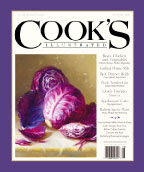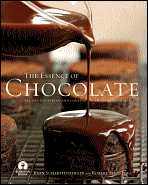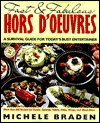
I'm an avid reader of Cooks Illustrated. The magazine, founded and edited by Chris Kimball, is about recipes, of course, but the interesting difference is the fine tuning the developers do with each and every subject. Now you can buy special book editions of Cooks Illustrated recipes.

I've been a magazine subscriber, though, for probably 20 years. They take no advertising whatsoever, and each issue is about 24+ pages long. Each contains maybe 10 articles altogether, so it's not overwhelming. They take a subject -- like cabbage, let's say, or brownies in this case -- and they not only develop the recipe or a group of recipes, but the writer explains the process in great length and detail. I like that - I enjoy reading about the trials and errors. That may not be for everybody, however. So they talk about the ingredients process, sometimes the chemistry behind food combinations, and explain why using something in the recipe didn't work and how she/he/they finally found the "right" recipe. Of course, it's just their opinion, but I've rarely been disappointed by any of C.I. recipes. They also do taste tests of canned or bottled items - like tomatoes, (Muir Glen won the last time they tested them) or paring knives, or pie crust shells. That kind of thing.
So, back to brownies. This recipe was printed in April, 2004. The recipe developers and authors, Erika Bruce and Adam Ried, worked on this recipe for awhile to come up with their combination. After reading the article I just had try it. I was doing a dinner party that weekend for a fairly sizable crowd, and wanted something like finger food for dessert. The brownies were prepared, baked, and about an hour before the guests arrived I carefully cut them up and delicately balanced rows of them on an elevated cake stand and covered them with plastic wrap so they wouldn't dry out before people got around to eating them. People began to arrive and someone oohed and aahed over the large stand full of brownies. She reached in and grabbed one and ate it right then. She was in ecstasy, she said. So, someone else had to have one. Then someone else. About a third of the brownies were gone before I'd even served appetizers (*$%!+$). But the consensus was that these were the best brownies. Do I agree?Absolutely. I've made them several times since then, just not recently.
So when I was telling my younger daughter, Sara, about the creation of my blog a couple of months ago, she immediately piped up and said,"Mom, the Best Ever Brownies have to go on your blog." Now she's an affirmed chocoholic from wa-a-ay back. But, this being 2007, I'd almost forgotten about them, lo these many years ago (3). Since I had a hankering for some chocolate today, and I'm meeting my friends Joan, Janet and Darlene later this afternoon for coffee, I thought I'd surprise them with a little treat. We have a new Peet's that's opened up about 4-5 miles away (we have another one closer, but it's small). The new one is large and has lots of outdoor seating. And it's not that crowded yet. I do love Peet's coffee - they have a corner on the foam market in my book. I know, some people don't like or want foam, but I love it. Theirs is dense and flavorful. Always. We buy our regular drinking coffee from Peet's and have for years. I make espresso mostly, but Dave drinks Peet's Decaf Sumatra nearly every day.
These brownies aren't all that unusual, really. If you put the ingredients side by side with other brownie recipes you might not find much difference. It probably has more eggs - 4 - and not a lot of flour (although it is cake flour) which gives them a bit of a chiffon texture, so they're not as cakey as some. There is a punch of chocolate in these, but they make 24, so really 6 ounces isn't all that unusual. The color of the finished brownie is more like cocoa, or milk chocolate, but there isn't any of either in the brownies. The chocolate flavor is certainly there, but it's not like these are dense or chewy.
 I've used Ghiradelli chocolate and Lindt too. And now I really like using Scharffen Berger. But in'04 people hadn't gotten into designer chocolate like they have now. When I entered the recipe into my recipe program I noted back then that I didn't have any unsweetened chocolate (which is what it calls for), so I'd used Valrhona dark instead and cut down on the sugar. Funny thing. I didn't have any unsweetened chocolate today, either, so I used Trader Joe's Bittersweet (it's a Belgian chocolate) and reduced the sugar by about 1/3. The pan preparation is a bit unusual - you line the pan in both directions with foil (leaving the edges hanging over the sides, which you use to grab ahold of when you're removing them), then spray the foiled pan with baking spray (the kind that has both oil and flour in it). I forgot to sprinkle the pecans on the top of these, as directed, but mixed them into the batter instead. Whatever you do, don't overbake these, and it's easy to do. I rely on my handy-dandy cake tester whenever I bake. My oven runs a few degrees hot, so I always cut down the temp by at least 5 degrees, sometimes 10, and reduce the baking time. These took 27 minutes today at 315 degrees.
I've used Ghiradelli chocolate and Lindt too. And now I really like using Scharffen Berger. But in'04 people hadn't gotten into designer chocolate like they have now. When I entered the recipe into my recipe program I noted back then that I didn't have any unsweetened chocolate (which is what it calls for), so I'd used Valrhona dark instead and cut down on the sugar. Funny thing. I didn't have any unsweetened chocolate today, either, so I used Trader Joe's Bittersweet (it's a Belgian chocolate) and reduced the sugar by about 1/3. The pan preparation is a bit unusual - you line the pan in both directions with foil (leaving the edges hanging over the sides, which you use to grab ahold of when you're removing them), then spray the foiled pan with baking spray (the kind that has both oil and flour in it). I forgot to sprinkle the pecans on the top of these, as directed, but mixed them into the batter instead. Whatever you do, don't overbake these, and it's easy to do. I rely on my handy-dandy cake tester whenever I bake. My oven runs a few degrees hot, so I always cut down the temp by at least 5 degrees, sometimes 10, and reduce the baking time. These took 27 minutes today at 315 degrees.
You could make a half of a recipe, which might be less dangerous to have around. These freeze nicely, however. See how long these last in YOUR house! And Sara, these are for you.
Classic Brownies (the best brownies ever)
Recipe By :Erika Bruce & Adam Ried
Source: Cooks Illustrated, 4/2004
Servings: 24
4 ounces pecans -- chopped
1 1/4 cups cake flour
1/2 teaspoon salt
3/4 teaspoon baking powder
6 ounces unsweetened baking chocolate -- chopped fine
1 1/2 sticks unsalted butter
2 1/4 cups sugar
4 large eggs
1 tablespoon vanilla extract
1. Adjust oven rack to middle position; heat oven to 325°. Cut 18-inch length foil and fold lengthwise to 8 inch width. Fit foil into length of 13 x 9 inch baking dish (preferably glass), pushing it into corners and up sides of pan; allow excess to overhang pan edge. Cut 14-inch length foil and, if using extra-wide foil, fold lengthwise to 12-inch width; fit into width of baking pan in same manner, perpendicular to first sheet. Spray foil-lined pan with nonstick baking cooking spray. If using nuts, spread nuts evenly on rimmed baking sheet and toast in oven until fragrant, about 4-8 minutes. Set aside to cool. Whisk to combine flour, salt and baking powder in medium bowl. Set aside.
2. Melt chocolate and butter in large heatproof bowl set over saucepan of almost simmering water, stirring occasionally, until smooth. (Alternatively, in microwave, heat butter and chocolate in large microwave safe bowl on high for 45 seconds, then stir and heat for 30 seconds more. Stir again, and if necessary, repeat in 15-second increments; do not let chocolate burn. When chocolate mixture is completely smooth, remove bowl from saucepan and gradually whisk in sugar. Add eggs one at a time, whisking after each addition until thoroughly combined. Whisk in vanilla. Add flour mixture in 3 additions, folding with rubber spatula until batter is completely smooth and homogenous.
3.Transfer batter to prepared pan; using spatula, spread batter into corners of pan and smooth surface. Sprinkle toasted nuts (if using them) evenly over batter and bake until toothpick or wooden skewer inserted into center of brownies comes out with few moist crumbs attached, 30-35 minutes. Cool pan on wire rack at room temperature about 2 hours, then remove brownies from pan by lifting foil overhang. Cut brownies into 2-inch squares and serve. Store leftovers in airtight container at room temperature up to 3 days (they won't last that long!).
NOTES : The first time I made them I didn't have the unsweetened chocolate, so I used Valrhona dark, which doesn't have as much sugar in it as some chocolate. In the same article the writers did a taste test of chocolates and the tasting team preferred Ghiradelli Bittersweet best. In 2nd place was Lindt Dark Chocolate. However, both of those contain sugar, so reduce sugar in the recipe if you use them.
Per Serving : 226 Calories; 14g Fat (51.6% calories from fat); 3g Protein; 26g Carbohydrate; 1g Dietary Fiber; 51mg Cholesterol; 73mg Sodium. Exchanges: 1/2 Grain(Starch); 0 Lean Meat; 2 1/2 Fat; 1 1/2 Other Carbohydrates.
To view a printable file, click on title at the top.











